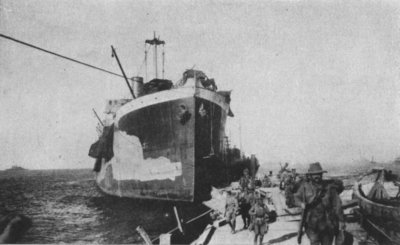SS River Clyde
|
|
The SS River Clyde was a 4,000 ton collier built in Glasgow in 1905 and named after the River Clyde in Scotland. On April 25, 1915, the River Clyde was used as a Trojan horse for the landing at Cape Helles during the Battle of Gallipoli. The ship, carrying 2,000 soldiers, mainly from the 1st Battalion of the Royal Munster Fusiliers, 29th Division, was beached beneath the Sedd el Bahr castle at V Beach, Cape Helles, on the tip of the Gallipoli peninsula. However, the plan failed and the River Clyde, lying under the guns of the Turkish defenders, became a death trap.
For the landing, the River Clyde was commanded by Commander Edward Unwin, a former merchant seaman and Royal Navy officer who had returned from retirement at the start of the war to command the torpedo gunboat, HMS Hussar, in the Mediterranean. The River Clyde had a battery of eleven machine guns from the Royal Naval Air Service mounted on the bow behind boiler plate and sandbags. Holes had been cut in the steel hull to provide sally ports from which the troops would emerge onto gangways and then to a bridge of smaller boats linking the ship to the beach. The hull was to be painted a sandy yellow as camouflage but the work was incomplete by the time of the landing.

Three attempts were made to get ashore by companies of the Munsters and The Hampshire Regiment but all ended in costly failure. Further attempts to land were abandoned and the surviving soldiers waited until nightfall before trying again. The efforts of sailors to maintain the bridge from the ship to the beach, and to recover the wounded, were rewarded by six Victoria Crosses. The recipients were Commander Unwin (aged 51), Midshipmen George Drewry (20) and Wilfred Malleson (18), Able Seaman William Williams (34), Seaman George Samson (26) and Sub-Lieutenant Arthur Tisdall (24) from the Royal Naval Division (RND). Of these men, only Williams died during the landing. Samson was severely wounded to following day. On his return to Scotland he was handed a white feather while wearing civilian clothes. Tisdall was killed on May 6 when the 6th (Hood) Battalion of the RND, made its advance along Kanli Dere during the Second Battle of Krithia. Drewry, Samson and Williams had come from the Hussar along with Unwin. Malleson, who died in 1975, served on the battleship HMS Cornwallis.
After the Helles beachhead was established, V Beach became the base for the French contingent and the River Clyde remained beached as a dock and breakwater. Her condensers were used to provide fresh water and a field dressing station was established in the hull. She remained a constant target for Turkish gunners on the Asian shore.
In 1919, after the war had ended, the River Clyde was refloated and taken to Malta for repairs. As a tramp steamer, she was operated by Spanish shipping companies for another 50 years in the Mediterranean under various names, the last being Maruja y Aurora. In 1965 there was an attempt to purchase the River Clyde for preservation but in 1966 she was sold for scrap instead and broken up at Aviles, Spain.
